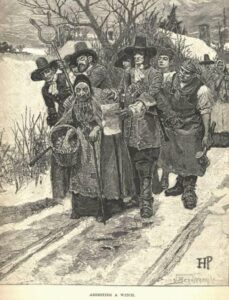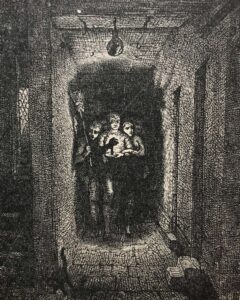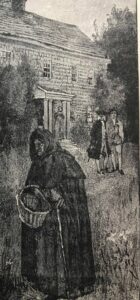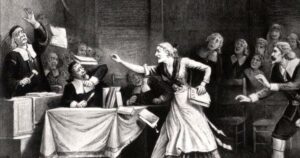THE SALEM WITCH TRIALS BEGINNING
PART 1
The Salem Witch trials took place from FEB 1892 and continued to May of 1893 before the people finally realized that something was wrong here. But to truly understand the panic of the people, we must go back a bit further in time. When trying to decide how to share the information that connects us to this history I was undecided. I have decided to do this as a series in order to get all the information together. So follow along as I lay out a map of events.
YEARS BEFORE
Back in the day EVERYONE believed in witches. They believed that men and women alike could make a bargain with the devil who gave them power to torment whoever they pleased. Everyone believed that the devil was very much like a man, except that he had wings like a bat, a tail, cloven feet, and horns, and that he was able to empower witches, enabling them to conjure up storms, sink ships, afflict children with fits, kill cattle, set chairs and tables to dance, and that they had the power to make themselves invisible and creep through keyholes,ride on broomsticks and delighted in holding orgies in the thunderstorms. To doubt the existence of witches was to reject the teachings of the Bible.
In 1488, four years before Columbus sailed in search of the New World, a storm swept over Constance, in Switzerland, which destroyed the corn and grapes and the people accused Anne and Agnes Mindelen of having raised it. They confessed that the devil put them up to it and they were burned to death. Two years before this in 1486, Pope Innocent VIII issued a bill directing that witches should be burnt, so we know they were in belief even before this.
When the wicked and cruel Alexander VI was in the papal chair, he set the Inquisitors to work to rid the world of witches. They burned six hundred poor old women in the bishoprie of Bamberg in Germany. By the shore of Lake Geneva, in 1515, during three months more than five hundred were burned to death. Can you even imagine? Innocent women were accused of horrible crimes by their neighbors and best friends and were led out by the shore, chained to stakes, wood piled around them and their bodies were smeared with pitch so that the fire might take better hold upon the bodies.
In 1549 the good Archbishop Cranmer gave these directions to the bishops: “You shall inquire whether any one makes use of charms, sorcery, enchantments, witchcraft, soothsayings, or any like craft invented by the devil.”
Countess of Lennox, who conspired against Queen Elizabeth was one who consulted witches.
ARCHBISHOP SPOTSWOOD
In 1591 Archbishop Spotswood spent nearly all his time examining witches. All throughout Spain, France, Germany, and Holland during this time, thousands of men and women were burned. In the village of Lindheim Germany which at the time contained only six hundred inhabitants, thirty were put to death in one year. Overall more than one hundred thousand were burnt at the stake.
In 1618 seventeen witches were condemned to death in Lancashire; sixteen in Yarmouth and fifteen in Chelmsford.
JUST THROW THEM IN THE POND 
When a woman was accused of being a witch, her hands were tied to her feet, and she was thrown into a pond. If she didn’t sink, it was considered proof that she was a witch and the devil had given her the power to float. If she did indeed sink and went to the bottom she was supposed to be innocent. Very few floated and nearly all the poor creatures were drowned while being proved innocent.
MATTHEW HOPKINS
Matthew Hopkins was appointed witch finder. He travelled through England, his expenses being paid, and a fat fee besides. He would examine their bodies for witch marks and arrested whoever he pleased. If a pimple, wart, or wen were discovered, it was an indication that a person was in conjunction with bad spirits! (OH MY! We are all witches! ) These were considered devil marks. The accused were subjected to terrible torture to get them to confess. It wasn’t long before more than one hundred persons were hung through Hopkin’s efforts. He was aided by some of the best men in England. One of those who suffered death at his hands was a good old minister who was 88 years of age and had preached over half a century. Hopkins threw him into a pond, and as he did not sink, it was a sure sign that he had sold himself to the devil. The good man died declaring to his last breath that he was innocent.
Hopkins was highly thought of by the people as he was thought to be of superior wisdom. However, he was soon accused also and as we know, paybacks are hell, right? His thumbs were tied to his big toes and he was thrown into the pond. However he managed to swim and insisted that he was not a witch and saved his neck from the noose.
SIR MATTHEW HALE
Sir Matthew Hale was lord of chief justice and was revered a good man, an upright judge, and presided at many of the witches trials. Amy Duny and Rose Cuflender were accused by Margaret Arnold of bewitching her little girl who was afflicted by fits.
“One day a bee flew into the face of my child, and a few minutes later she vomited up a two penny nail. At another time my little girl caught an invisible mouse which she threw into the fire, and it instantly flashed like gunpowder.” she said.
Nearly all the accusations were as silly as this.
Sir Matthew called upon Thomas Brown who was considered a great and learned physician at the time, to give his opinion. Mr. Brown felt that the fits were natural but that they had been heightened by the devil cooperating with the witches.
Sir Matthew was a tender hearted man but with the testimony of the greatest physician in England ruled that the devil and two old women were making the child sick. The Bible commanded that he put them to death and he ordered them executed.
Later Sir Matthew wrote a book about witchcraft. Soon Rev. Richard Baxter, a learned and godly minister, wrote another. Shortly after Rev. Perkins published a third book, all three telling of the horrible crimes and incantations of the witches. The Printers of London kept their presses busy, printing pamphlets about witches. No one doubted the stories told by the accusers, especially when so many of the accused confess that they were in a league with the devil. I think it was a damned if you do damned if you don’t situation. I mean what are you going to do?
GOSSIP SPREADS LIKE FIRE
Now every vessel crossing the Atlantic brought news of the doings of the witches in England, as well ast books and pamphlets to the settlers’ homes all over New England and Virginia. Governors, judges, ministers and people alike read them, and believed what the good men like Chief justice Hale and Richard Baxter had written. When anything out of the norm happened that they couldn’t account for, of course the witch did it. If the butter would not come in churning, the cream was bewitched. And the way to get the witch out was to heat a horseshoe red hot and drop it into the churn. This would so scorch the hag that she would leave in a twinkling. A horseshoe nailed over a door would prevent witches from entering it. (and we thought it was for good luck right? ) 
Ministered preached about witches and warned their listeners that the Prince of the Power of the Air was all around them, going up and down the earth looking for who he might devour. By the wide mouthed fireplaces in the old kitchens stories were told of what the witches were doing. Listeners felt their flesh creep and their hair stand on end while the stories were told. Timid people were afraid to go outside after dark, sure that they might encounter a ghost or hobgoblin. Boys and girls, if sent to the cellar for a mug of cider or for apples, were terrified of seeing a shadow on the wall. When they climbed the stairs to bed it was with a quick and nervous step (you know the kind…we’ve all done it!!) for there was no telling what was behind the boxes and barrels in the garret. When lightning flashed or rain beat hard against the windows, they thought of the witches that were flying through the air on broomsticks or holding a revel in the forest. The dim pale light that they sometimes saw along the marshes was will-o-the wisp or the devil’s wish…ready to lure them into some snare. The devil was ever around them and the witches would do his bidding.
 MARGARET AND THOMAS JONES
MARGARET AND THOMAS JONES
Now about the time that Matthew Hopkins was tossing women into the ponds and hanging them, the people of Charlestown, Massachusetts, in 1648, accused Margaret Jones of being a witch. She was a doctor and used roots and herbs for healing. The idea was that she had a “malignant touch;” that if she laid her hands on a person in anger they would become blind, deaf, or in some way afflicted. She was imprisoned, and the man who guarded her said that he saw a little child with her, which instantly vanished.
She naturally declared her innocence but the people protested that she was in league with the devil, and she was executed.
John Winthrop who kept a diary said “the day and hour she was executed there was a very great tempest in Connecticut, which blew down trees, and did much damage” . The superstitious people firmly believed that the devil was taking vengeance upon the country.
Margaret’s husband Thomas, had a sorry time of it after she was hung. People pointed their fingers at him, and made life so miserable that he went on board a ship bound for Barbadoes. It was a small vessel, and there were eight horses on the deck, which made it top heavy. While at anchor in the harbor the craft started to roll fearfully, and the superstitious sailors said that Thomas Jones was the cause of it and hustled him on shore and into prison as a witch.
HUGH PARSONS
People were such firm believers in witchcraft, and so credulous, that it was easy to create a suspicion against a person, and many women were accused of being witches by their jealous and envious neighbors. One of the settlers of Springfield, Massachusetts, Hugh Parsons, sawed boards and planks for a living. He worked hard during the day and filed his saws at night, and made money faster than some of his neighbors, who through jealousy, perhaps, accused him of being a witch. He was arrested and Hannah Lankton and her husband testified that one day they had boiled pudding for dinner, and when they took it out of the bag it was cut open lengthwise, as if with a knife. They did not know what to make of it, and said it was bewitched. They threw a piece of it into the fire, and soon after Mr. Parsons came to the door, which convinced them that he had bewitched it. A neighbor could not get a tap out of a beer barrel, but Mr. Parsons pulled it out without any difficulty, which was sure proof that he was a witch.
Mrs. Parsons was sick and became insane, and the people said that she had sold herself to the devil. Her little child died, and they said that she and her husband had poisoned it. They were put in prison, and the neighbors testified against them.
One man saw snakes in his room at night. A woman saw a light flickering around her petticoat, a cow would not give milk, a woman had a pain in her breast, a little girl said that she saw a dog, though no one else could see it. Others saw things that they could not account for, which made them think that their neighbor Parsons was a witch. Although he and his wife were cast into prison, the judges did not think they were witches and they were not put to death. In nearly every town there were men and women who were suspected of being witches.
 GENERAL MOULTON
GENERAL MOULTON
Hampton, New Hampshire had a witch, General Moulton, who made money so fast that his superstitious neighbors said that the devil helped him. One day his house caught fire and the people said that the Evil One had done it because the General had fooled him. He had bargained with Satan to fill one of his boots every night with gold. The devil came to fill it, and was amazed to find that it took several cart loads. Wondering how so small a boot could hold so much, he made an examination, and discovered that the General had cut a hole in the sole and another in the floor, and the gold had run through it, and he had filled the cellar. Infuriated he blew a flame from his mouth and set the house on fire!
I will stop here for now and prepare another post. Stay tuned for the next post. Hope you have enjoyed my series to this point. If so please leave me a comment in the comment section and I look forward to bringing you more in the coming days. My source for this infomation was basically from the book Old Times in the Colonies by Charles Carleton Coffin, copyright 1908 by Sallie R. Coffin. No copyright infringement intended.
Thank You for stopping by and Happy Hunting
The Pierce Family Historian

Love it! And thank you. I saw one typo, 3 paragraphs from the end…..I think “mand” should be “man”? I will try to wait patiently for the next installment.
Nyla Nutsch Poser
Thanks sometimes new eyes are helpful! new post going up today.